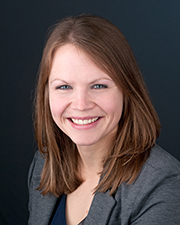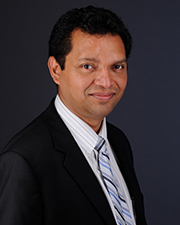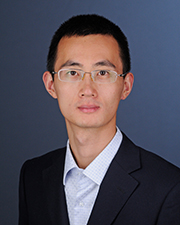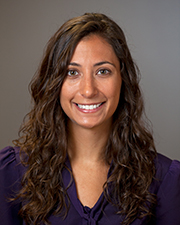Four KU Engineering Professors Awarded for Early Career Success
Four assistant professors at the University of Kansas School of Engineering each received a prestigious grant designed to support junior STEM faculty members establish a lifetime of leadership in their respective field.
The recipients of the National Science Foundation CAREER awards are Emily Arnold, assistant professor of aerospace engineering, Juan Bravo-Suárez, assistant professor of chemical and petroleum engineering, Huazhen Fang, assistant professor of mechanical engineering, and Elaina Sutley, assistant professor of civil, environmental and architectural engineering. Each received grants worth $500,000 over five years.
“For four faculty members to receive this award in one academic year is a remarkable achievement,” said Arvin Agah, Dean of Engineering at KU. “This recognition highlights just some of the world-class research and teaching being conducted at KU Engineering, as well as the caliber of our junior faculty.”
The awards are designed to assist “promising junior faculty to pursue cutting-edge research while simultaneously advancing excellence in education,” according to the NSF.
“To have the NSF support me is humbling and very honoring,” said Sutley, a sentiment echoed by Bravo-Suárez and Fang.
A look at the four recipients and their research.
Emily Arnold

Arnold started at KU in 2015. Her five-year, $609,000 NSF CAREER grant to incorporate radar and antenna into a UAS helicopter, then fly the vehicle over two precarious ice sheets in Greenland to better measure bed topography and crevasse size — metrics proven hard to obtain otherwise.
“It’s a technology development grant where we’re integrating some small radars and antenna systems onto a helicopter UAS platform for the purpose of sounding and imaging glaciers,” Arnold said. “From a technology standpoint, the innovative aspect is how we’re going to structurally integrate the antennas into the vehicle itself. We’re going to use these and the platform to fly over what are known as outlet glaciers. Specifically under this grant, we’re going to do it in Greenland, but the same technology can be used in Antarctica. These outlet glaciers are really difficult to measure because they’re fast-flowing. They’re highly crevassed, which makes it more difficult for us to detect the bed or anything else we’re trying to measure.”
Arnold and collaborators, including a KU graduate student, will travel in 2021 to Greenland’s Helheim Glacier, where they’ll share logistic resources with fellow KU researchers Leigh Stearns, associate professor of geology; Carl Leuschen, associate professor of electrical engineering & computer science, and Shawn Keshmiri, associate professor of aerospace engineering — all of whom are working on Center for Remote Sensing of Ice Sheets projects related to measuring ice sheets. Two years later, Arnold plans fieldwork at a second Greenland ice sheet called Jakobshavn.
Juan Bravo-Suárez

Bravo-Suárez came to KU as an adjunct professor in 2013, then became an assistant professor a year later. His research group primarily works out of the Center for Environmentally Beneficial Catalysis.
Bravo-Suárez’s project has a goal of expanding the ethanol market by converting ethanol to valuable products like acetic acid, which is used in the production of photographic film, synthetic fibers and fabrics and even in food products.
Scientists can already make such conversions, Bravo-Suárez said, but they do not fully understand how and why the process works — only that it does. By using tools and techniques developed in his lab like in situ spectroscopy, he said, researchers can now take a peek at how the chemical process works. “We still have to imagine” how it works, Bravo-Suárez said, “but we have to imagine less.”
Using that knowledge researchers can develop ways to make the conversion of ethanol to acetic acid and other products cheaper and cleaner. “That we avoid going through current commercial — and maybe not environmentally friendly — processes," Bravo-Suárez said. “It's a more direct and cheaper way of producing it.”
Bravo-Suárez has been recognized for his work before. In 2017, he received a grant from the American Chemical Society Petroleum Research Fund that helped him develop the tools and techniques he will use on the NSF grant. “It's been a process, working three, four years,” he said. “To finally see the results of that is very rewarding.”
Huazhen Fang

Fang, who joined the KU Engineering faculty in 2014, is leading research to make the use of lithium-ion batteries safer. The rechargeable batteries are increasingly used in portable electronics and also have military and transportation uses, but have an unfortunate tendency to get hot and catch on fire. A few well-publicized thermal incidents happened in recent years, including fires in a broad range of commercial EV models.
"Those events caused a lot of user concerns,” Fang said. “That is a question that must be addressed.”
Fang’s research aims to develop reliable mathematical models that can predict, and thus prevent, such “thermal behavior” — with potentially huge benefits to the transportation and energy sectors. “Lithium-ion batteries are quite good, but if they're not safe, consumers will have concerns,” Fang said. Another important aspect of the research is to blaze a trail for battery thermal management by combining a battery’s thermal physics and artificial intelligence. The overall goal is to make a battery “smart” about its thermal conditions so that it would not fall victim to a thermal event.
The project will also include “more and better research opportunities for students at all levels,” Fang said, including outreach activities to engage K-12, undergraduate and graduate students.
He added: “This is an exciting and also humbling honor.”
Elaina Sutley

Sutley came to KU in 2015. Her NSF CAREER project will examine the role different types of buildings play in helping a community withstand disaster. Under current building codes, Sutley said, buildings are rated on a four-point scale according to the importance in helping a community survive the first days of a catastrophe. “Death counts go way up if a hospital is damaged” Sutley said, so hospitals are rated accordingly — and designed to higher standards to help them survive an extreme event.
That scale “has done a good job in protecting lives, but has not prevented widespread damage and long-lasting recovery times,” Sutley said. Her project will reassess the scale, bringing knowledge from a wide array of disciplines — engineering, computer science, sociology, urban planning, public planning and more — to assess how different types of buildings support a community’s need to function. Topmost in mind, she said, is one fact: “The people who are most socially vulnerable are the most impacted by these events.”
Facilities such as grocery stores, nursing homes and schools may find themselves more highly rated under the system Sutley and her team develop.
“This is especially important because of the increasing frequency and cost of disasters. According to the National Oceanic and Atmospheric Administration, 2017 is the most expensive year on record for weather and climate related disasters in the U.S., with more than $360 billion in direct losses. This level of annual damages has significant implications,” Sutley said.
Sutley’s project is in support of one of the NSF 10 Big Ideas on convergence research. Sutley said she was particularly excited to blend different fields of study, including sociology and engineering, in her work. “These are two disciplines that don't really know each other,” she said. “So I'm really grateful to help build this space in the literature and knowledge base.”
The NSF has existed since 1950 to promote discovery in the sciences and to fund those on the frontier of scientific innovation. The CAREER awards are intended to aid recipients as they build a foundation for a lifetime of integrated contributions to both research and education.